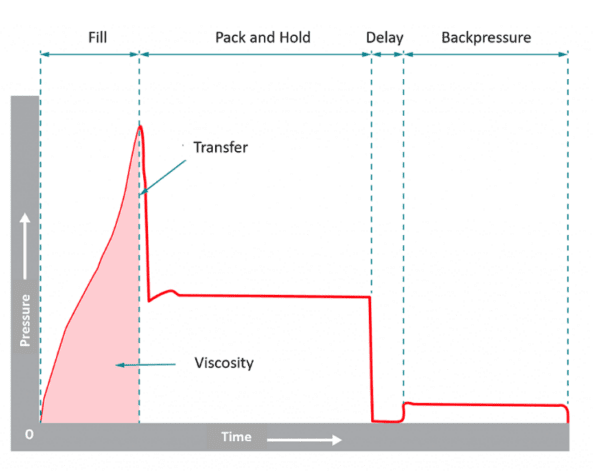
Injection Pressure: What Is It, How to Calculate It, and Why It Matters – RJG Blog
Injection pressure is a crucial parameter in the process of injection moulding. Injection pressure builds by the force of the injection unit and the area of the screw pushing molten plastic into the mould cavity.
The injection pressure is typically measured in pounds per square inch (psi) or bars (1 bar = 14.5 psi). It is one of the most important factors determining the final product’s quality and consistency.
The injection pressure required for a particular application depends on various factors such as the type of plastic material, the product’s size and shape, and the mould’s design. The injection pressure should generally be high enough to fill the mould cavity completely without causing any defects or voids in the finished product. At the same time, it should not be so high that it causes the mould to break or the plastic to degrade.
Fill Pressure, Pack Pressure, and Hold Pressure
The fill pressure and pack and hold pressures are present in the moulding process. The fill pressure is the pressure required to fill the mould to a certain level (95 to 98% of part volume). The pack pressure is the pressure applied after the mould is filled. Packaging the plastic into all the corners and crevices of the mould cavity is required. Hold pressure is the pressure applied during the plastic cooling phase to ensure that the plastic remains in contact with the mould surfaces and to minimize/control shrinkage on the part. Higher fill pressures, as a result of high fill speeds, can help to improve the effect of packing and holding pressures of the part, which in turn can result in higher-quality finished products.
How to Calculate Injection Pressure
Injection Pressure as a concept is any pressure built up when the screw is pushing plastic forward towards the mould (fill, pack or hold). Injection pressure is the variable that provides some of the most vital information we need to understand and adjust the process as necessary. A simple equation determines injection pressure:
P=F/A
Where: P=Pressure, F=Force, and A=Area.
Think about the formula like this: pressure is the result of a force being distributed across a determined area. For the purpose of injection moulding, we can add this: pressure is the result of a force being distributed across a determined area at a specific time. We add the variable time to this definition because injection pressure is applied within specific time periods during a cycle. We can look at the amount of pressure being applied over time on a pressure vs time graph, as shown below.


Accounting for Viscosity Shifts
The goal for any moulder is to create a stable and consistent process, resulting in repeatable, good quality plastic parts. That’s pretty obvious, right? However, the reality is that often isn’t the case. With so many variables influencing every shot, it’s no wonder the graph curves often don’t match against each other shot after shot. Material, process parameters, mould, and machine conditions that aren’t well-defined are causes that create defective parts. Material condition and viscosity are the most common variables that cause inconsistent quality. This viscosity shift can vary greatly from one production run to another or even within the same production run.
The injection pressure curve allows us to visualize this viscosity shift and act accordingly to account for it. If we look at a graph, we can see the material viscosity represented as the area under the curve during fill stage, as shown below.

Conclusion
In conclusion, injection pressure is a critical parameter in the injection moulding process that affects the quality and consistency of the final product. It is determined by various factors such as the type of plastic material, machine condition, the size and shape of the product, and the design of the mould. The injection pressure should be high enough to fill the mould cavity completely without causing any defects or voids in the finished product but not so high that it causes the mould to break or the plastic to degrade.
Careful monitoring and control of injection pressure are essential to achieve consistent and high-quality finished products. The injection pressure curve reveals a lot more information as well that we will unpack in future blog posts. Stay tuned!
Read more from RJG here.
RJG
+44 (0)1733 232211
Website
Email






